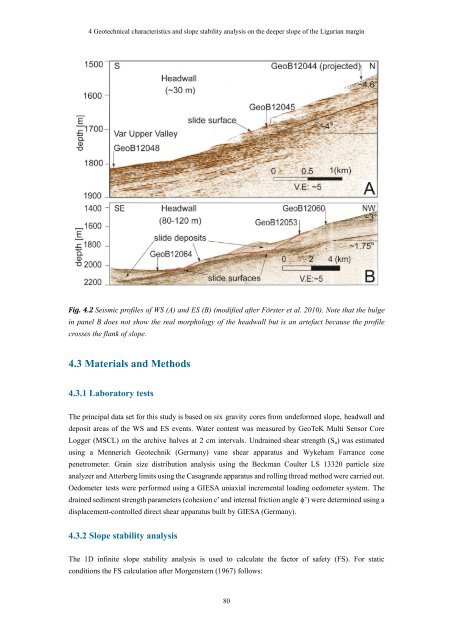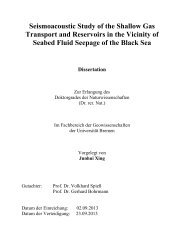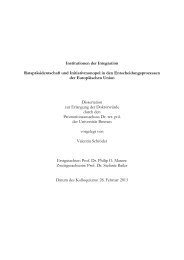Slope stability along active and passive continental margins ... - E-LIB
Slope stability along active and passive continental margins ... - E-LIB
Slope stability along active and passive continental margins ... - E-LIB
Create successful ePaper yourself
Turn your PDF publications into a flip-book with our unique Google optimized e-Paper software.
4 Geotechnical characteristics <strong>and</strong> slope <strong>stability</strong> analysis on the deeper slope of the Ligurian margin<br />
Fig. 4.2 Seismic profiles of WS (A) <strong>and</strong> ES (B) (modified after Förster et al. 2010). Note that the bulge<br />
in panel B does not show the real morphology of the headwall but is an artefact because the profile<br />
crosses the flank of slope.<br />
4.3 Materials <strong>and</strong> Methods<br />
4.3.1 Laboratory tests<br />
The principal data set for this study is based on six gravity cores from undeformed slope, headwall <strong>and</strong><br />
deposit areas of the WS <strong>and</strong> ES events. Water content was measured by GeoTeK Multi Sensor Core<br />
Logger (MSCL) on the archive halves at 2 cm intervals. Undrained shear strength (S u ) was estimated<br />
using a Mennerich Geotechnik (Germany) vane shear apparatus <strong>and</strong> Wykeham Farrance cone<br />
penetrometer. Grain size distribution analysis using the Beckman Coulter LS 13320 particle size<br />
analyzer <strong>and</strong> Atterberg limits using the Casagr<strong>and</strong>e apparatus <strong>and</strong> rolling thread method were carried out.<br />
Oedometer tests were performed using a GIESA uniaxial incremental loading oedometer system. The<br />
drained sediment strength parameters (cohesion c’ <strong>and</strong> internal friction angle ϕ’) were determined using a<br />
displacement-controlled direct shear apparatus built by GIESA (Germany).<br />
4.3.2 <strong>Slope</strong> <strong>stability</strong> analysis<br />
The 1D infinite slope <strong>stability</strong> analysis is used to calculate the factor of safety (FS). For static<br />
conditions the FS calculation after Morgenstern (1967) follows:<br />
80
















